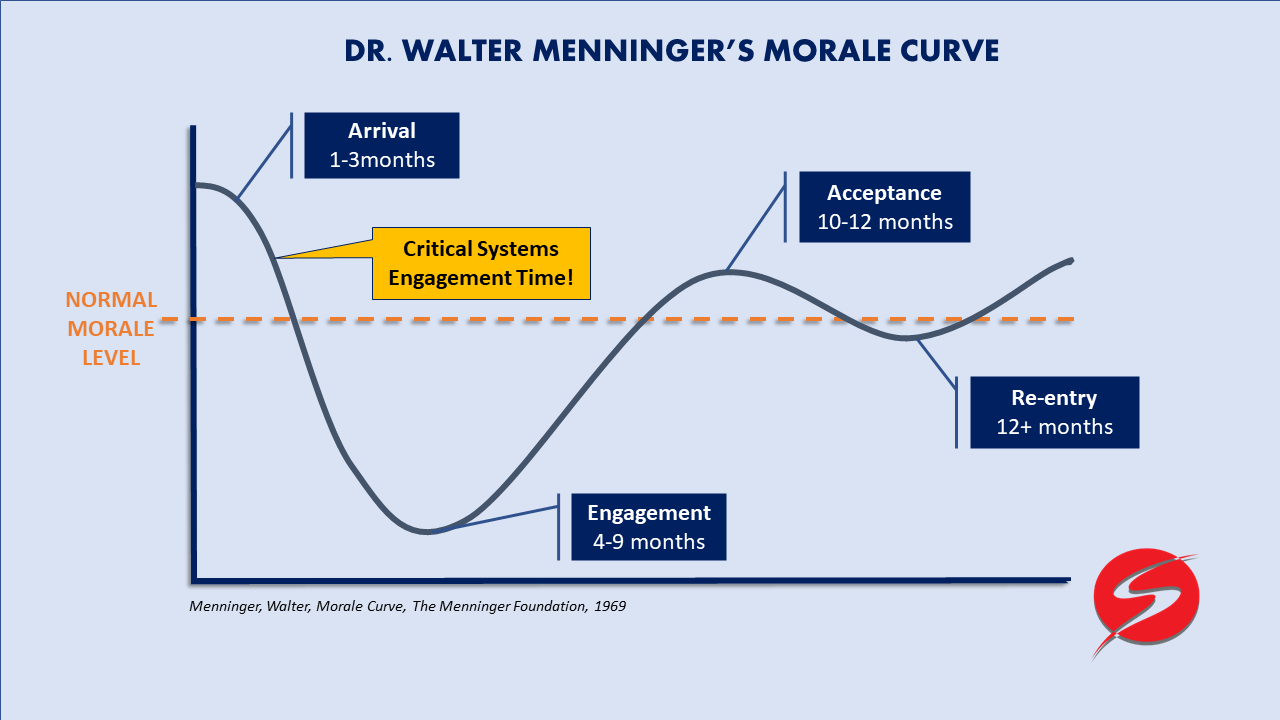|
Download your free whitepaper defining 13 tips for effective use of situational leadership!
Download this free, short article that speaks of one way to deal with dissent on your work teams!
What do you value when you look internally for growth? Are you looking for others "like you" or are you willing to hire a diverse mix of minds? How do your facility systems play a part in keeping your employee morale high? Do you even think it plays a part? First, let me explain that in this instance, what I mean by facility systems are the institutions within your company to keep employees engaged. This would include training programs, financial compensation, benefits, managerial support and development, as well as processes. So what is the connection with employee morale? Let's discuss.
In the 1950's Dr. Walter Menninger conducted a study and through his research he developed what is called the "Menninger Morale Curve" that employees experience. In this model, he defines four stages of employee development. These stages are arrival, engagement, acceptance, and re-entry. For the purposes of this discussion we are focusing only on the arrival, engagement, and acceptance stages (see chart below). In the arrival stage, the employee is eager to show their worth. This is also referred to as the "honeymoon stage". They have high expectations. Why shouldn't they? They just experienced an onboarding telling them how awesome your company is! At least they should have. Now is the time to live up to it. First impressions are very important! This new employee is also what can be referred to as "unconsciously incompetent". That is, they don't know what they don't know about the operations. They are ready to go and learn all they can. Very quickly though, something tends to happen to them. As your new employee experiences the daily responsibilities and requirements of their new job, they can become overwhelmed. Also, let's face it, encounters with some negative employees don't help. They may tend to think, "how can anybody remember all of this?" This can then inevitably cause their morale to begin to dip. They have now become what can be referred to as "consciously incompetent". They now KNOW what they don't know! This all tends to happen around the 90 day mark. It is therefore CRITICAL that we engage our employees with our internal "systems" to keep from losing them. It is at this engagement stage where we can either get them turned in the right direction, or lose them altogether, thus, creating turnover. We want to begin engaging them BEFORE they reach the bottom of this engagement curve. The lower they sink, the harder it will be to capture them. This is why it is so important to have a clear and achievable pathway to the development of a new employee. At onboarding and throughout their first 90 days is the optimum time to ensure they take part in necessary job training. Not skimping on their development or "throwing them to the wolves" so to speak. Those are sure turnover machines. When we define what they need to know, when they need to know it, how they will learn it, and with whom they will learn it, this makes our new employees feel more secure in your investment in them. Also, managerial support during this time is critical! They should know who their manager is, know how to get in touch with them, and have by now had meaningful dialog with them. This serves to encourage those overwhelmed by the job. It makes them feel that the company believes in their abilities and their performance usually reflects that belief. What can truly make this work is if we give our new employees a visible pathway to increased compensation throughout the development and performance process. We can tie financial increases to stages of growth on the job. By attaching levels to job knowledge along with pay differentials, it not only gives the employee goals to reach for, but will in turn help us to see the qualification level of our workforce. We can quickly ascertain where we need to focus our training efforts. It's also a must if we intend to cross-train. If we engage our new employees with effective internal systems before they reach the engagement "pit" or dip, we move the employee much quicker toward the acceptance stage. This is where they get a good grasp on their responsibilities, have accepted the way things are, and have become empowered to make decisions on the job to get the outcomes they wish for. It is at this stage where your employee moves on to being what is referred to as "consciously competent". They now KNOW what they KNOW. They are thinking employees. Paying close attention to each step they perform. It is important that we continue training them for advanced techniques during this time. This keeps them moving forward. Remember, our employees are an investment in our company's success. It takes time and effort to properly engage and train employees. Sure, this can cause some discomfort in production due to the need for staff quickly at times. However, to keep throwing bodies at an issue without the proper development only leads to higher turnover which lowers overall company morale and exacerbates the issues we already have. Good training systems, good benefits, and good and fair compensation with growth potential are the tried and true systems that when applied properly and timely to employees will result in lower turnover and higher morale. Isn't this what we all want? For assistance in developing your onboarding and training systems, contact Success Strategy Training and Development. Let's have a conversation about your needs! Imagine, if you will, a skilled maintenance technician. He/she is called to fix a problem on a machine. They have a standard set of tools that they take with them. They get to the machine , and realize that the tool they need is not in their bag. They go back and get this tool and their manager suggests that they add this special tool to their bag. They do just that. On the next call, they need a tool that they only use maybe once a month. Again, the suggestion is to add it to their bag. As this continues to happen, the technician ends up with a burdensome and excessively heavy bag filled with things they rarely use. It creates needless confusion and slows them down significantly.
Do we find that our work instructions end up this way? They are intended to be used by our employees, but have they become havens for information to satisfy auditors, engineers, lawyers, quality managers, and accountants? Maybe something happens once or twice and we say, "add it to the work instruction". If we continue down that path, we end up with large multi-page documents that are hard for our employees to utilize on the job. We expect our employees to follow these documents in performing the steps of our process correctly, but if they can't find the "steps" among all of the regulations, are they beneficial? Can they be effective training documents for new employees? Pat Sweeney, www.explainers.com, offers four main elements that work instructions must contain in order to be effective. They must be...
This creates documents that are much shorter, and can be utilized for effective employee training. It will help us achieve that holy grail of manufacturing, "standard work". Where there is too much direction, there is no direction. Therefore, when we pull the clear steps, or directions away from the regulations, we are on the way to creating clear documents that our teams can really use. That's just covering some of what make our documents clear. There is so much more to making them clear, as well as credible, accessible, and consistent, which we didn't cover. Work instructions should be the life of our processes. Success Strategy can assist in making these documents live for your organization. Contact us to schedule an information session for your facility decision makers. Keenan McBride, CPTM  My wife presented me with a very interesting quote today that she just knew that I would love. This is due to ideals that I am always speaking on when we have one of our random "educational" discussions (yes...we do that). The quote is this... "Everybody is a genius. But if you judge a fish by its ability to climb a tree, it will live its whole life believing that it is stupid." - Albert Einstein How genius is that?! It is an indictment on how we publicly educate. Using the same mold and trying our best to stuff uniquely gifted children into it versus discovering where their genius lies and teaching to it. Granted, we have to educate some generally accepted standards, but we should incorporate ways to bring out a child's gift and area of ability. The same applies to adult learners in the workplace. We typically stuff people into a box of either being auditory, visual, or kinesthetic. We say, "you HAVE to be one of these". The truth is, most of us represent a blend of these generally accepted learning methods. This is why training is most effective when we incorporate all three methods into our learning activities. It increases the likelihood for retention, understanding, and more effective knowledge transfer. We don't "tell the FISH to climb a tree", as it were. You give the fish water and tell it to swim, and give the tree to the monkey and tell it to climb. Each gifted in their own way...like people! A small lesson (roughly 8 min) on humility and leadership. |
Author Keenan McBride, CPTM Archives
August 2021
Categories |
||||||||||||

 RSS Feed
RSS Feed